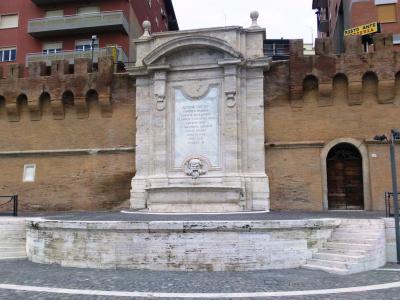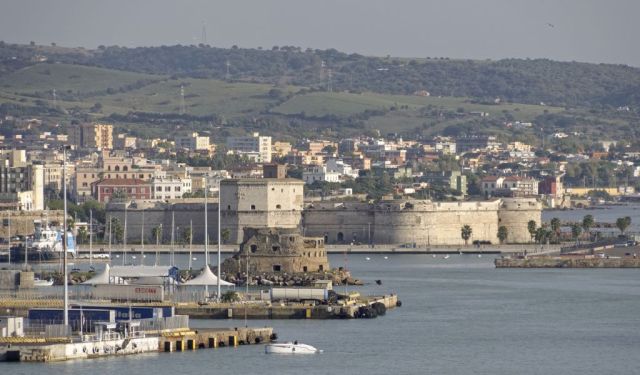
Fontana del Vanvitelli (Vanvitelli Fountain), Civitavecchia
The Vanvitelli Fountain is one of the most significant and well-preserved historical landmarks of the Port of Civitavecchia. Located north of Fort Michelangelo, along the defensive walls built by Pope Urban VIII, this travertine fountain was commissioned in 1740 by Pope Benedict XIV to replace an older basin in the same location. The fountain was completed in 1743 by the renowned architect Luigi Vanvitelli, whose work has left a lasting mark on Italian architecture. Its design features the head of an old faun, framed within an aedicule with a curved tympanum, accessible via a curved staircase, adding to its artistic and historical charm.
The fountain is intimately connected to the history of Civitavecchia’s port defenses. In 1630, when the port’s franchise was restored, Pope Urban VIII saw the necessity of fortifying the city against potential enemy landings and incursions. As a result, long defensive walls were constructed, separating the port from the rest of the city. Additional security measures were later introduced, including barriers made of nets, wooden beams, and chains, anchored to blockhouses at the port’s entrances to prevent night-time attacks. Behind these fortifications, remnants of ancient Roman structures were covered, some of which can still be admired inside historic fishmonger stalls, showcasing opus reticulatum, a distinctive Roman masonry technique widely used during the reign of Emperor Augustus.
Today, the Vanvitelli Fountain and the historic defensive wall can be appreciated in their full splendor thanks to a restoration project that lasted nearly two years. Visitors can take a picturesque walk through history, following the path along the walls from Fort Michelangelo to the fountain, where the aged faun sculpture offers a symbolic welcome to the Port of Civitavecchia.
The fountain is intimately connected to the history of Civitavecchia’s port defenses. In 1630, when the port’s franchise was restored, Pope Urban VIII saw the necessity of fortifying the city against potential enemy landings and incursions. As a result, long defensive walls were constructed, separating the port from the rest of the city. Additional security measures were later introduced, including barriers made of nets, wooden beams, and chains, anchored to blockhouses at the port’s entrances to prevent night-time attacks. Behind these fortifications, remnants of ancient Roman structures were covered, some of which can still be admired inside historic fishmonger stalls, showcasing opus reticulatum, a distinctive Roman masonry technique widely used during the reign of Emperor Augustus.
Today, the Vanvitelli Fountain and the historic defensive wall can be appreciated in their full splendor thanks to a restoration project that lasted nearly two years. Visitors can take a picturesque walk through history, following the path along the walls from Fort Michelangelo to the fountain, where the aged faun sculpture offers a symbolic welcome to the Port of Civitavecchia.
Fontana del Vanvitelli (Vanvitelli Fountain) on Map
Sight Name: Fontana del Vanvitelli (Vanvitelli Fountain)
Sight Location: Civitavecchia, Italy (See walking tours in Civitavecchia)
Sight Type: Attraction/Landmark
Sight Location: Civitavecchia, Italy (See walking tours in Civitavecchia)
Sight Type: Attraction/Landmark
Walking Tours in Civitavecchia, Italy
Create Your Own Walk in Civitavecchia
Creating your own self-guided walk in Civitavecchia is easy and fun. Choose the city attractions that you want to see and a walk route map will be created just for you. You can even set your hotel as the start point of the walk.
Civitavecchia Introduction Walking Tour
Civitavecchia, meaning "ancient town," is a major port on the Tyrrhenian Sea that historically served as Rome’s maritime gateway. Founded by the Etruscans, it was later developed by Roman Emperor Trajan in the 2nd century and was originally known as Centum Cellae or “Hundred Cells.” The latter name was probably due to the many vaulted "cells" forming the harbor wall, some... view more
Tour Duration: 2 Hour(s)
Travel Distance: 2.2 Km or 1.4 Miles
Tour Duration: 2 Hour(s)
Travel Distance: 2.2 Km or 1.4 Miles

